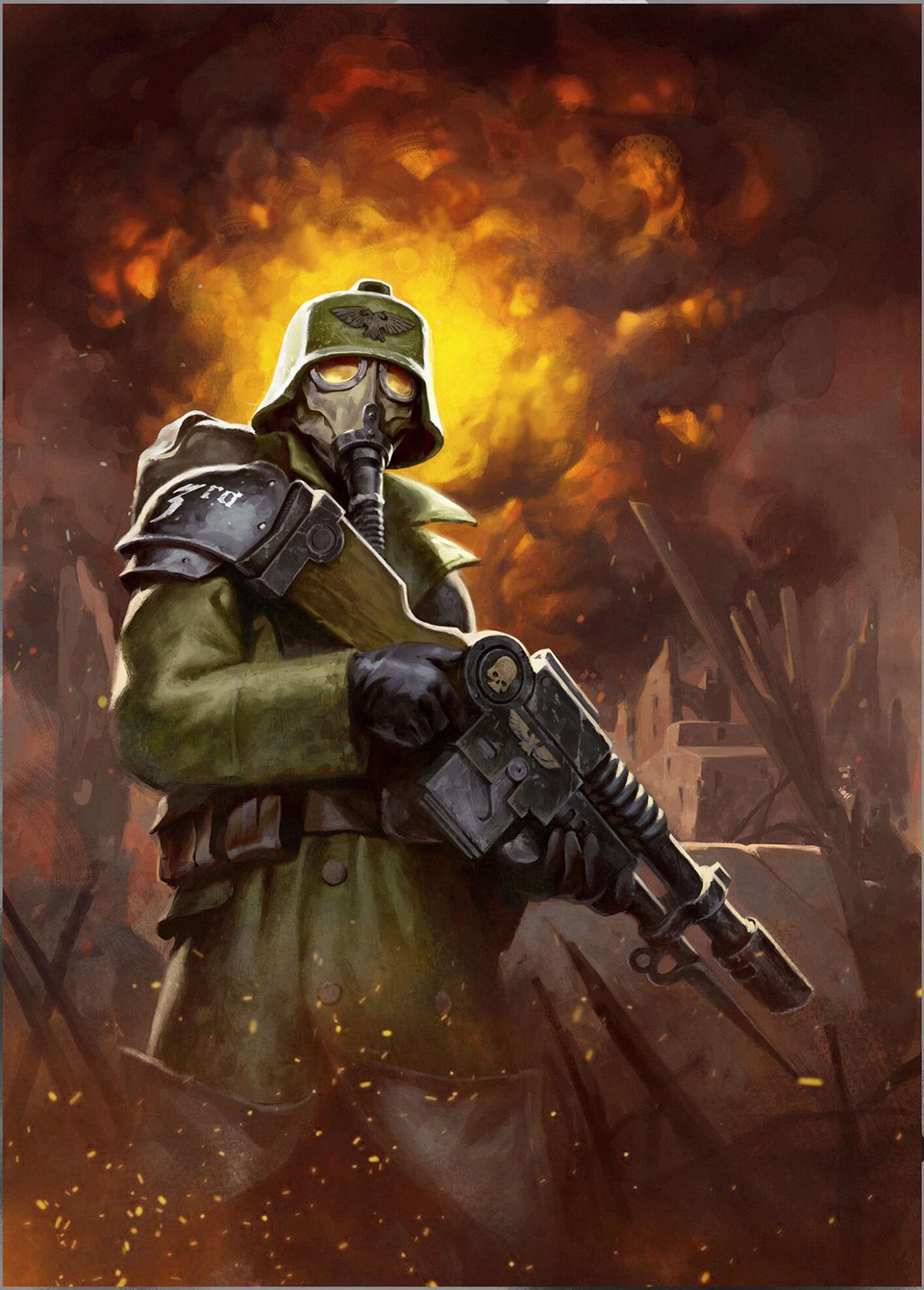Death Korps of Krieg: Forged in Atomic Fire Part II
WARHAMMER 40KDEATH KORPS OF KRIEGASTRA MILITARUM
Oroslan
3/31/202415 min read
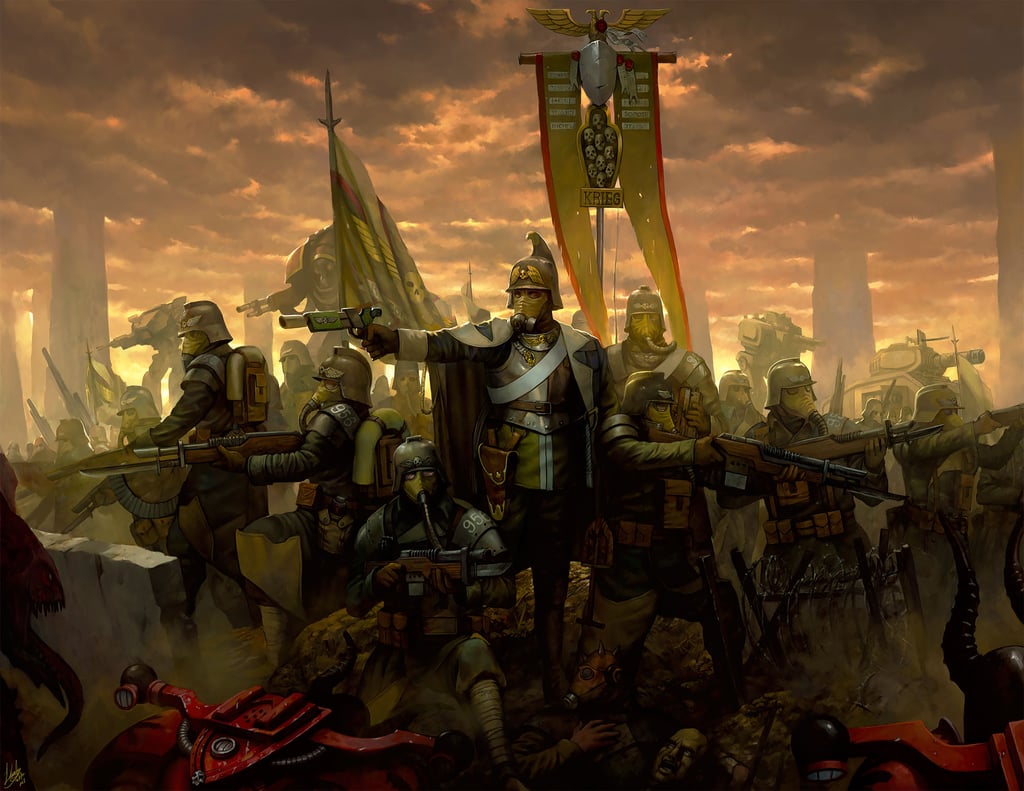

New Krieg, new war
When Krieg returned to the fold of the Imperium, Astra Militarium accountants immediately calculated that the planet had incurred a tithe debt. Krieg had to supply more soldiers to the Imperial Guard than he ever could. However, the planet supplied twenty regiments at once, and these were not young men ready for recruitment. These were well-trained warriors, already with equipment and the ability to kill. The commander of each regiment requested the most dangerous fronts of the galactic war for his formation. Their requests, of course, were granted.
Krieg resumed trade with other planets in the Segmentum. He did not have raw materials, so he paid with weapons, which he produced in his underground manufactorums, built and debugged during the years of the civil war. Krieg used the new resources to strengthen its production in order to arm and equip even more soldiers to serve the Imperium. Need I say that this planet has no analogues? It could not give away precious metals and other natural resources for the benefit of Humanity. Krieg has only one resource left - people. Warriors.
The deployment of the first regiments of the Death Korps was extremely successful - they showed amazing efficiency. As well as the incredible mortality rate, but Krieg quickly replenished the ranks of his regiments. The Astra Militarium generals soon realized how to take advantage of this. They used Kriegs on death worlds and in situations where it was more economically profitable to achieve the goal by losing a couple of Krieg regiments, but without turning to the Adeptus Astartes for help. In a sense, the Death Korps served as the Penal Legion. But where several tens of thousands of penalty soldiers would have been required, one Krieg regiment solved the task without any problems.
Since Krieg could not grow anything on the surface and had no resources, Deportamento Munitor agreed that the planet would pay with soldiers. Perhaps for this reason, the Lords of Terra turned a blind eye to Krieg's use of forbidden eugenics programs. They began to be used back in the time of Jurten to stop mutations in newborns, which became a natural consequence of radioactive poisoning of the planet. It is quite possible that the matter on Krieg went much further than typical eugenics, but... no one conducted an investigation. Neither the Astra Militarium nor the Adeptus Miechanicus.
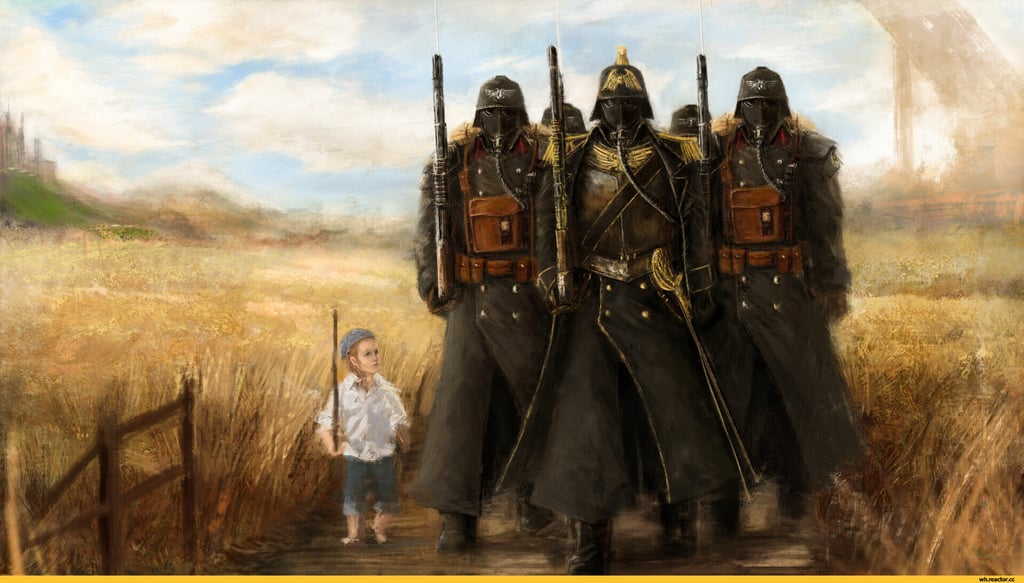

It is believed that the use of Vitae-Womb technology, once developed by the Biologis Magos and prohibited for all without exception, is sanctioned on Krieg. Well, that is, there is an exception - Krieg. Nothing is known about Vitae-Womb other than the name of the technology, so many are sure that it is just a myth. One way or another, Krieg really “produces too many soldiers,” especially for the world of death. Therefore, the theory of using the technology of replication of living organisms seems logical. There is mention of a certain “breeding livestock program”. According to one version, we are talking about the legendary Krieg horses; according to another, this is an ironic name for the process of replication of Krieg soldiers.
Today Krieg is also classified as a "Military World". Typically, this class includes worlds where active combat operations are taking place. And they are indeed being waged on Krieg - constant war on the surface is part of the training system for its soldiers. And while a world of comparable population yields one Imperial Guard regiment per Terran decade, Krieg easily yields several dozen regiments.
In general, the Astra Militarium views the Kriegs with guarded distrust. The Death Korps are exceptionally effective, their warriors intelligent and courageous. And although they never sacrifice themselves unnecessarily, yet... very often, even too often, they sacrifice themselves in situations where it is more advisable to retreat. And with warriors from other units of the Imperial Guard, they basically cannot find a common language. However, recruitment from Krieg is constantly growing, and the Astra Militarium is devoting more and more resources to building fleets for the Kriegs and equipping regiments with heavy equipment. Why? It's simple. In a future where there is only war, only those born of war can give humanity a chance at peace.
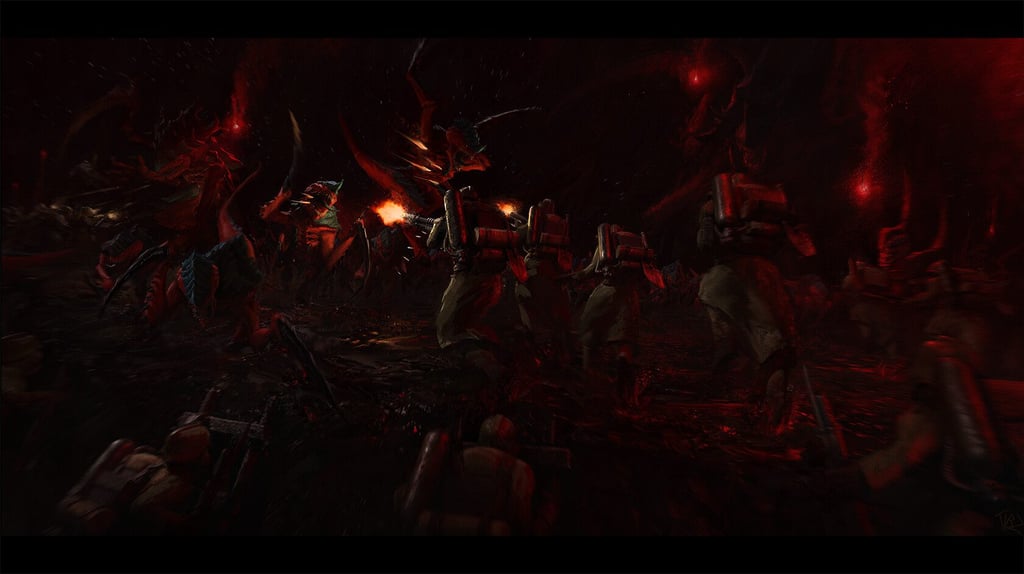

Recruitment, combat doctrine, deployment techniques
In terms of recruitment (we are not considering the replication theory because nothing is known about it), Krieg is somewhat different from other planets. Here every boy is a future recruit; initially he has no alternative. We do not have exact data, but according to rough estimates, harsh training eliminates more than half. Most of them die, the survivors go to work in underground factories producing weapons, equipment and ammunition.
What is interesting (and very cruel) is that all recruit training is carried out on the surface of the planet, in a poisoned atmosphere, among ruins and ashes. Training battles between companies on Krieg are not training at all - future soldiers of the Imperium fight with real weapons. And they die in these battles for real too. Moreover, Krieg seems to have its own Penal Legion, which is used to confront recruits at the final stages of training, when they are practicing full-fledged combat operations (perhaps those same “rejected” ones are enrolled in the Penal Legion).
Again, we do not have exact information regarding how Krieg works with recruits in terms of psychological preparation. It is obvious that future soldiers of the Death Korps are, as they say, brainwashed. Although, given the history of the world and the fact that the current Kriegs are the descendants of the people of Jurten from Ferrograd, we can safely assume that no special propaganda is required here. The children of Krieg with their mother's milk absorb great guilt for the betrayal of their planet and the desire to atone for the sins of their native land at any cost. But they also imbibe honor, courage and sacrifice. Sincere absolute devotion to the Emperor and Humanity.
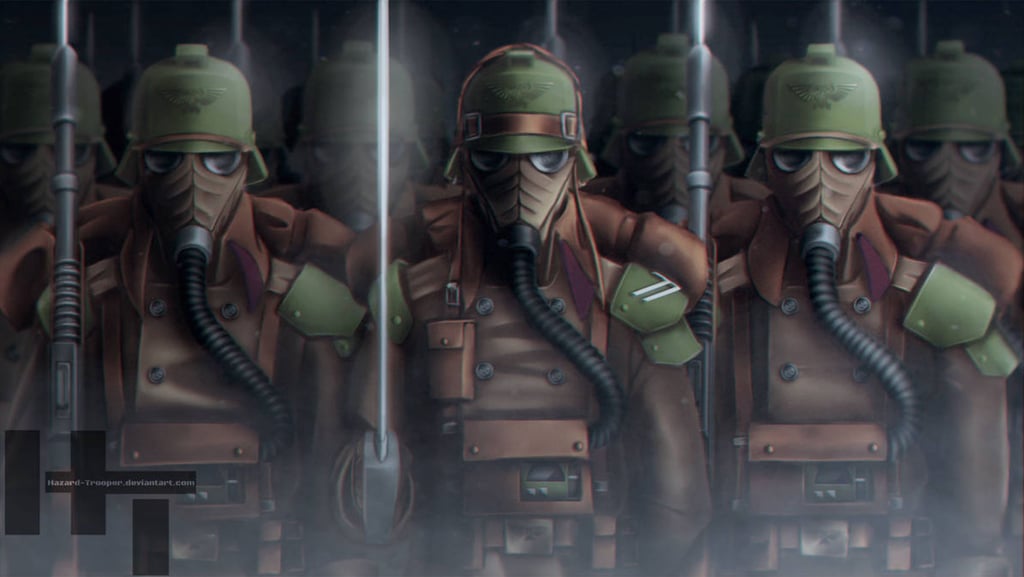

As for Krieg's combat doctrine, you need to understand that during the civil war, when the planet's infrastructure was practically destroyed, the loyalists simply could not allow the weak to live, who consumed scarce resources without giving anything in return. As a result, strict natural selection was introduced, when the strong became stronger and the weak died (such is Sparta in 42k). The second aspect was, as imperial culturologists called it, the Cult of Sacrifice, expressed in a simple postulate: no sacrifice can be too high a price for the opportunity to serve the Emperor.
It is unfair to say that Kriegs are straightforward. They know strategy and tactics, they are true masters of war, for they were born for it. Krieg’s commanders, of course, focus not on maneuver, but on killing. Not because of inexperience. And because the formation of an advantage in the direction and brutal suppression of the enemy by numbers is almost always the fastest option for achieving the goal. And every minute saved in this battle becomes a mine that the Death Korps can serve the Emperor in another.
Krieg's generals say that any battle where their ability to fight and their desire to die exceeds that of the enemy has already been won. The rest is a matter of resource depletion. Discipline, combined with the Cult of Sacrifice and unconditional loyalty to the Emperor, makes Krieg soldiers more than just fanatics. They do not flinch from sudden explosions, do not begin to breathe faster when they are on the verge of death. This ensures their trigger fingers never wobble and their sights never go astray. This is the secret of the Death Korps - why its soldiers run longer and shoot more accurately. That's why they are the best.
Krieg's Death Korps truly excelled in trench and siege warfare, because this is how their ancestors fought for centuries, liberating their home planet from the rebels of the Autocrat. But these are not the only types of war that Krieg knows. Death Korps soldiers participated in the Third War for Armageddon, in the campaigns on Taros, Atria, and Florenza III. And there they not only dug trenches, but also carried out lightning assaults, implemented the blitzkrieg strategy, and organized ambushes.
Krieg knows how to fight in different ways. But when he goes on a counterattack, it becomes clear to everyone that it is the Death Korps who are attacking. Because the Kriegs always go on the attack along the entire front at once and always with the support of regimental artillery, which, according to rumors, is not inferior in accuracy and lethality to the death machines of the Ordo Reductor.
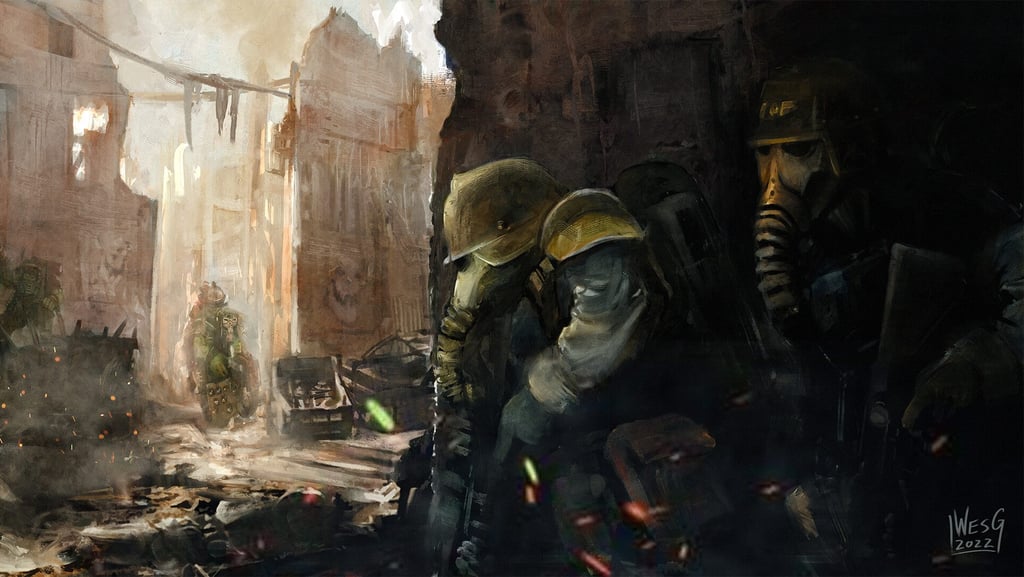

All Death Corps units have two characteristic attributes - gray overcoats and masks with respirators. They almost never take off their masks. This gesture is a direct reflection of their combat doctrine. Because a Corps soldier is not a person. He has no face - only a mask. He has no name - only a number. He has no destiny other than glorious service and glorious death in the name of the Imperium. In this, all Krieg soldiers are equal, so there should be no differences between them. Evil tongues immediately recall replication and cloning, but Lyons’ “Dead Men Walking” puts all the dots here - Kostellin managed to see the faces of several Kriegs. And they were different.
Regimental organization
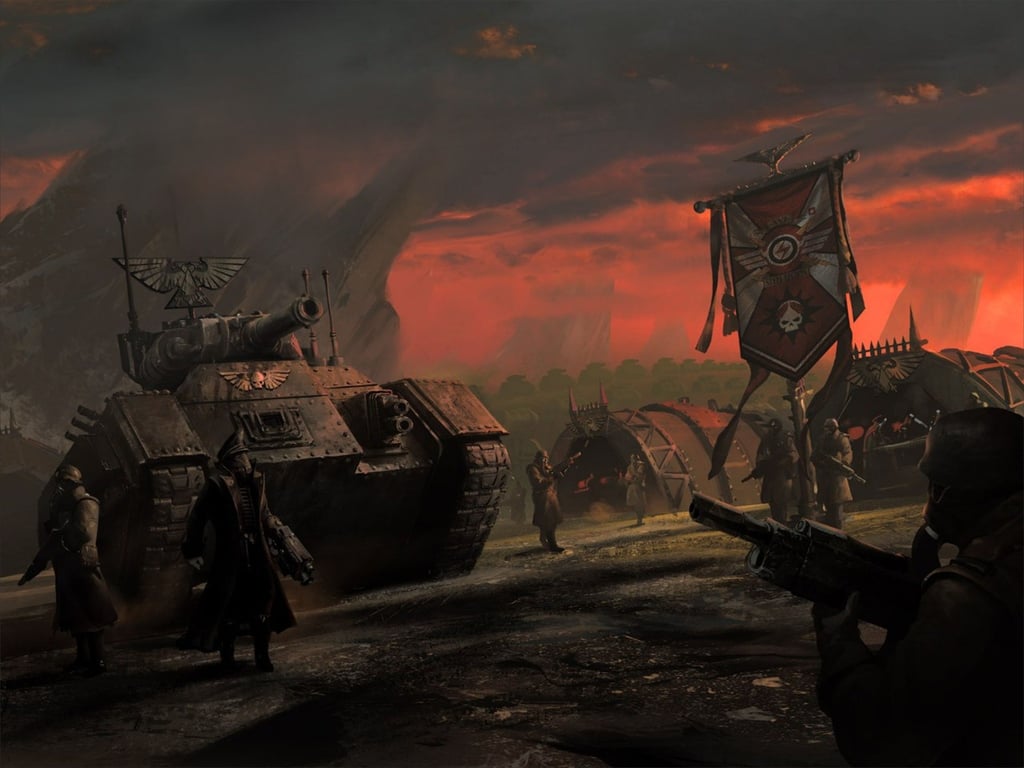

The regimental organization of Krieg is in many ways typical of the Imperial Guard - there are ordinary soldiers, sergeants, senior officers (overseers), commissars, motorized rifle and armored units. There are guard detachments made up of the most experienced veterans. They may differ in individual uniform elements and details, including in accordance with the specifics of the world in which they are currently serving. The mask and greatcoat (gray, brown, sand or dark green) remain unchanged.
However, there are several types of soldiers in the Death Korps that are not found in other units of the Imperial Guard, or that differ significantly in equipment and functions. These are the grenadier, death rider, engineer and quartermaster. Let's take a closer look at them.
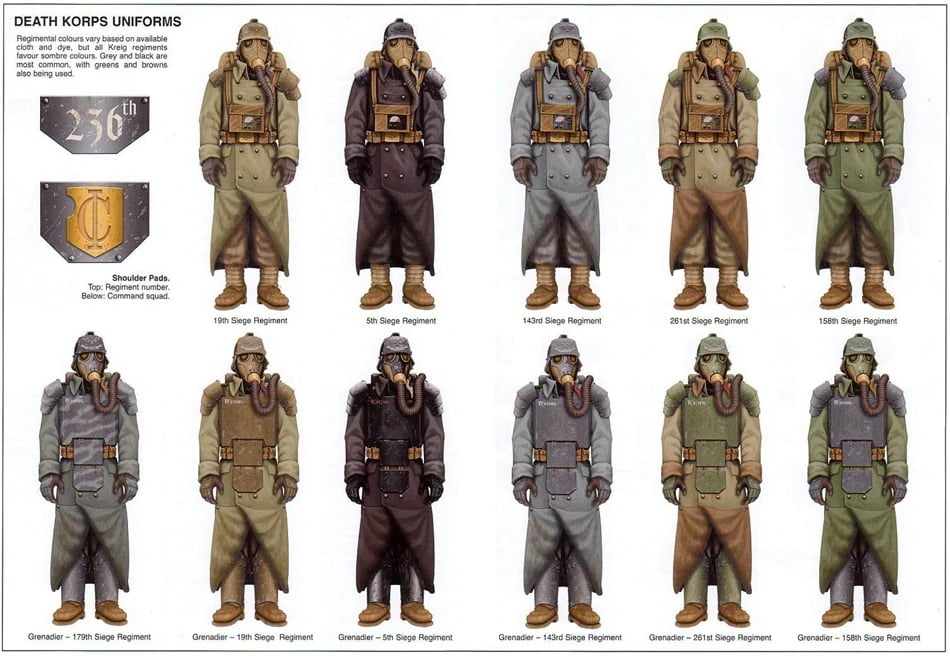

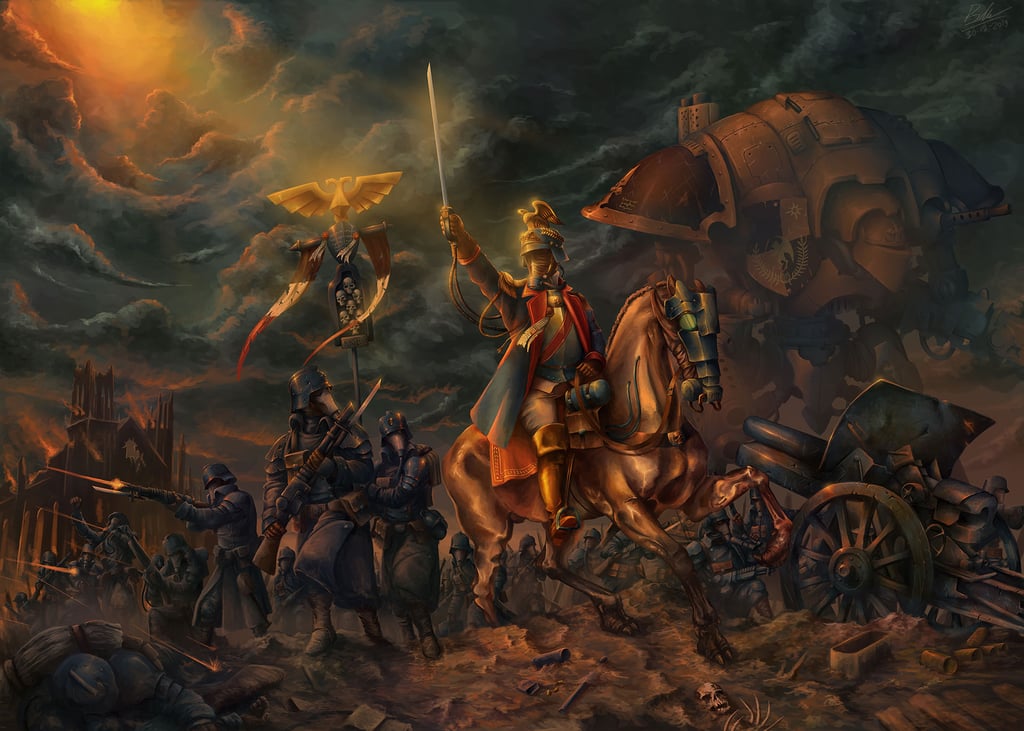

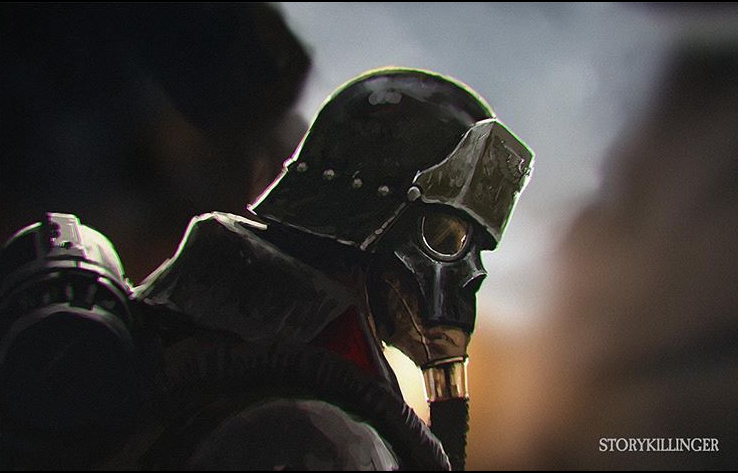

Death Korps Grenadier of Krieg
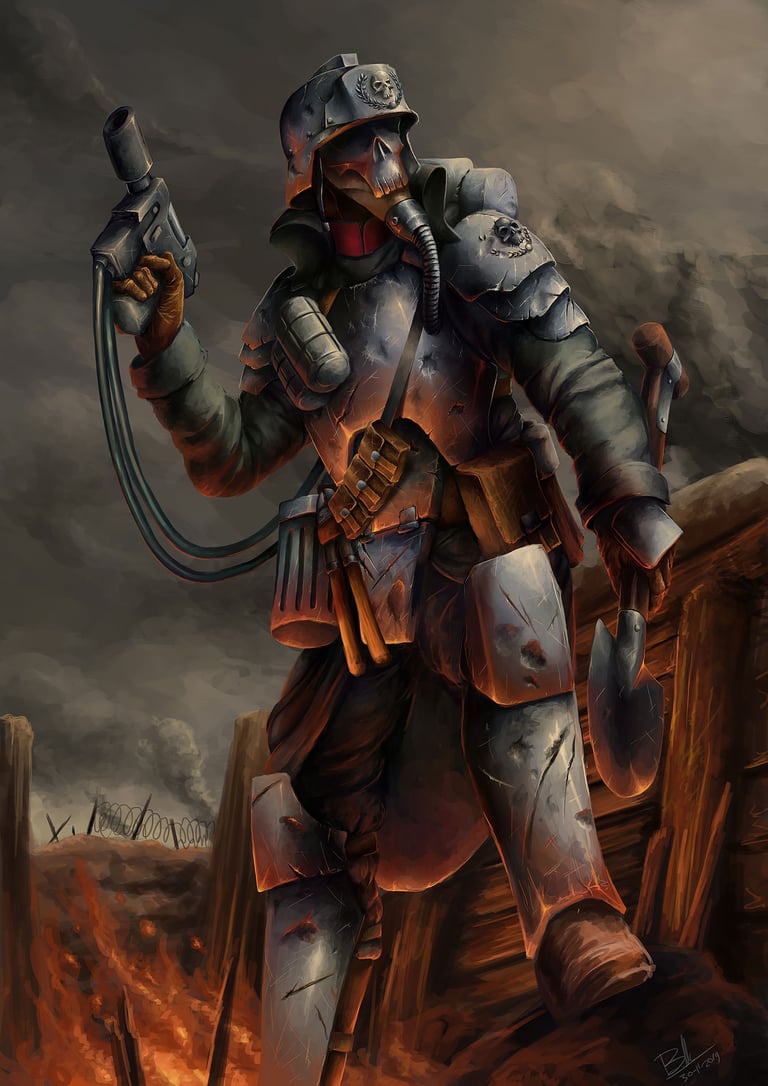

Grenadiers form a kind of elite in the infantry units of Krieg. They are selected by commanders and commissars from among the veterans. Also, grenadiers often become soldiers who are the only survivors of their units. They do not receive promotion in rank or position, but are highly respected due to experience and status.
Grenadiers are technically heavy infantry - they are equipped with armor made of plasteel and ceramite, and are armed with hellguns (heavy lasgun type XIV), meltaguns and flamethrowers, sometimes with heavy flamethrowers, requiring a crew of two. Grenadiers form the leading edge of the front in breakthrough areas, so it is not surprising that according to statistics, 8 out of 10 grenadiers die in the next battle.
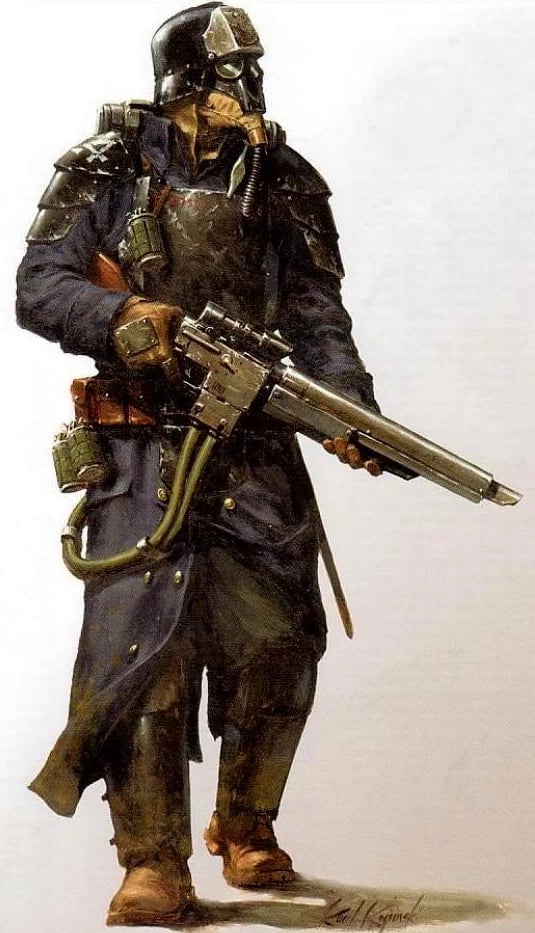

Interestingly, grenadiers are often returned to regular infantry units after some time. It is probably assumed that in this way they pass on experience to other soldiers, and also inspire them by personal example.
Death Korps of Krieg Death Rider
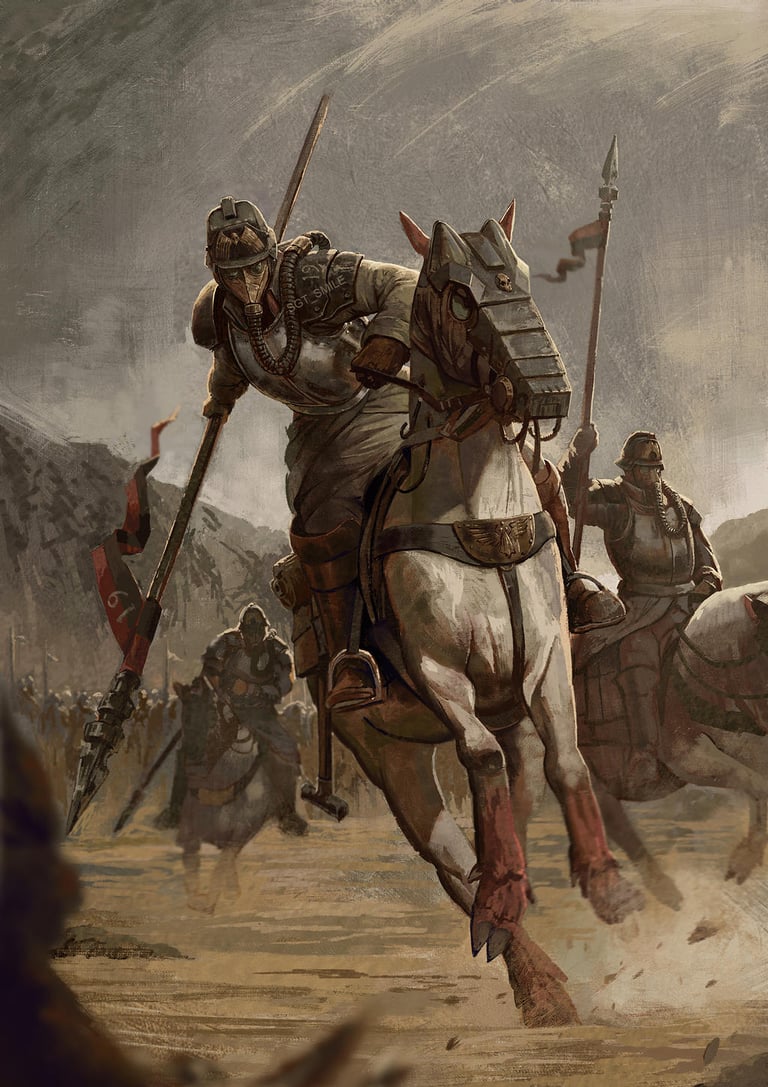

These are cavalry units that have counterparts in other infantry formations of the Imperial Guard. However, the Death Rider, in addition to blitzkrieg tactics and absolute fearlessness, are distinguished by the fact that they use the legendary Krieg horses. These horses are the product of genetic engineering; they were bred on Krieg during the Civil War era.
The peculiarity of the Krieg horse is that it possesses a number of conceptual biological modifications, including an improved respiratory system and redundant organs. As a result, Krieg horses can survive even the most toxic atmospheres and endure injuries that would prove fatal to most living creatures. Raised in so-called "vats" under the care of the Adeptus Mechanicus, Krieg horses have subcutaneous armor and an integrated injection system that injects drugs, hormones and other substances into their bloodstream as needed. Jokes aside, it looks like, without exaggeration, this is a Space Marine horse.
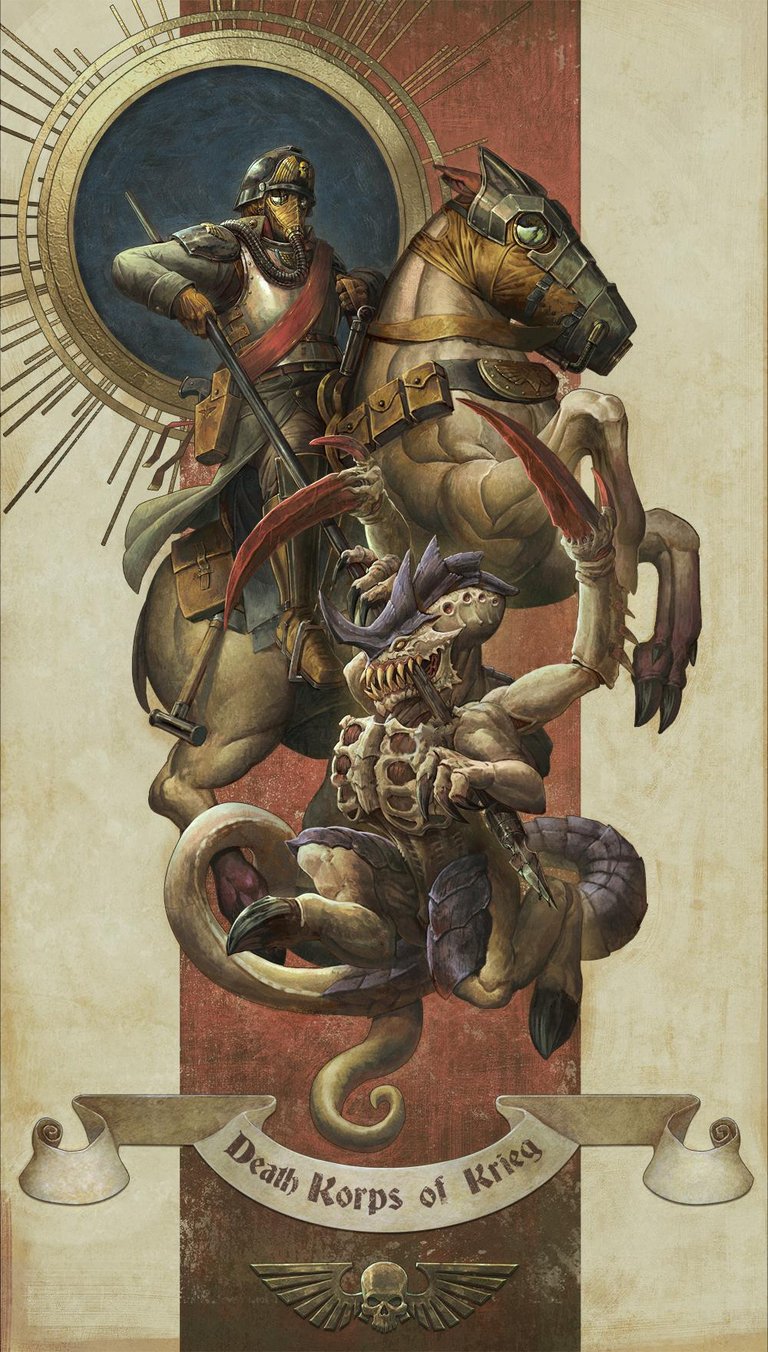

Riders for Krieg horses are selected from veterans, but in addition to experience and luck, candidates require two more parameters - initiative and innovative tactical thinking. In this way, the Horsemen of Death differ significantly from other Krieg units - they act more independently and aggressively. The riders are armed with laspistols, sabers and spears with exploding tips, traditional for imperial cavalry.
Engineer Krieg
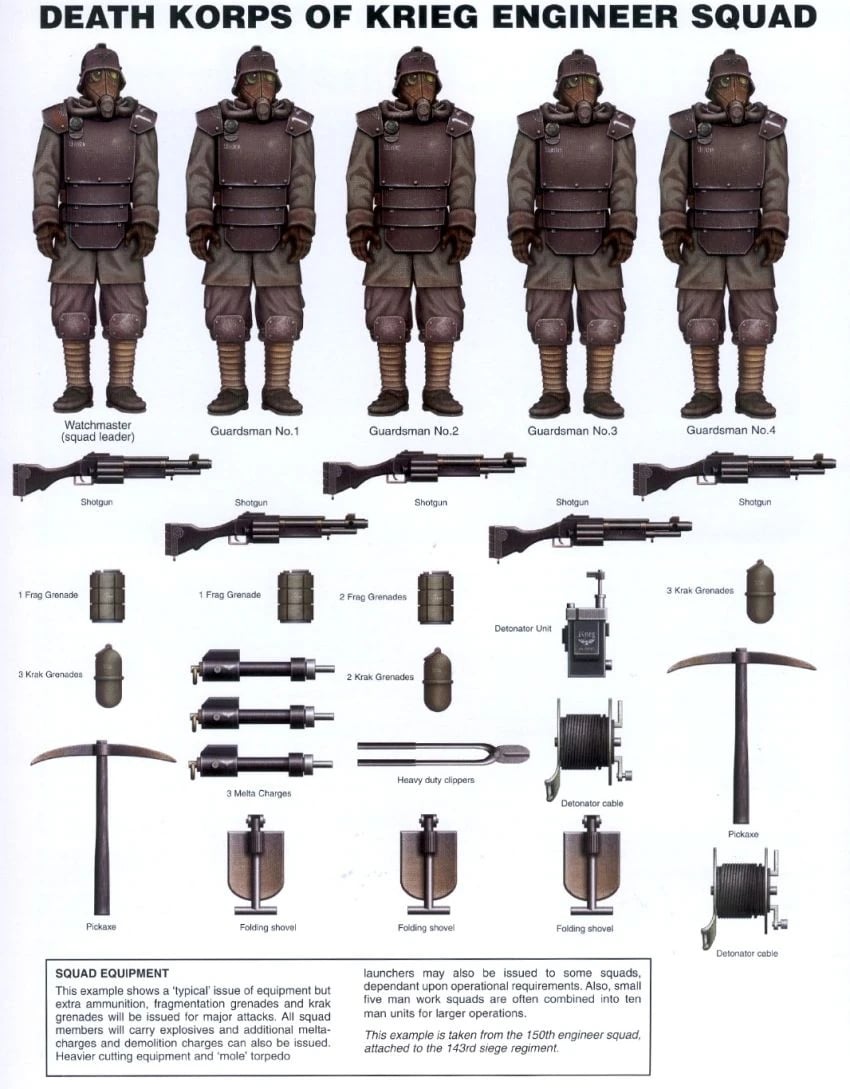

Engineers specialize in building fortifications. Their task is to create a system of trenches and bunkers on the target sector of the front, which will allow Krieg soldiers to restrain the enemy as effectively as possible. However, their functions do not end there.
Krieg Engineers are often called masters of underground warfare, and they truly have no equal in this unique tactic. Thanks to the actions of engineers deep behind enemy lines, a whole network of underground passages can suddenly open up, from which thousands of infantrymen in gray and even detachments of Horsemen of Death will suddenly pour out in deathly silence.
Such underground passages are called saps. Krieg engineers dig saps in such a way that they cannot be detected by enemy detection means. In just a few days, saps can entangle all enemy positions right down to the rear. And at the signal, high-explosive mines will be detonated in the required areas, the passages will open and key points will be occupied by the Kriegs in a matter of minutes. If the saps do not allow them to penetrate or bypass enemy defenses, engineers can plant explosives under strategic points of the enemy's defensive systems and undermine them.
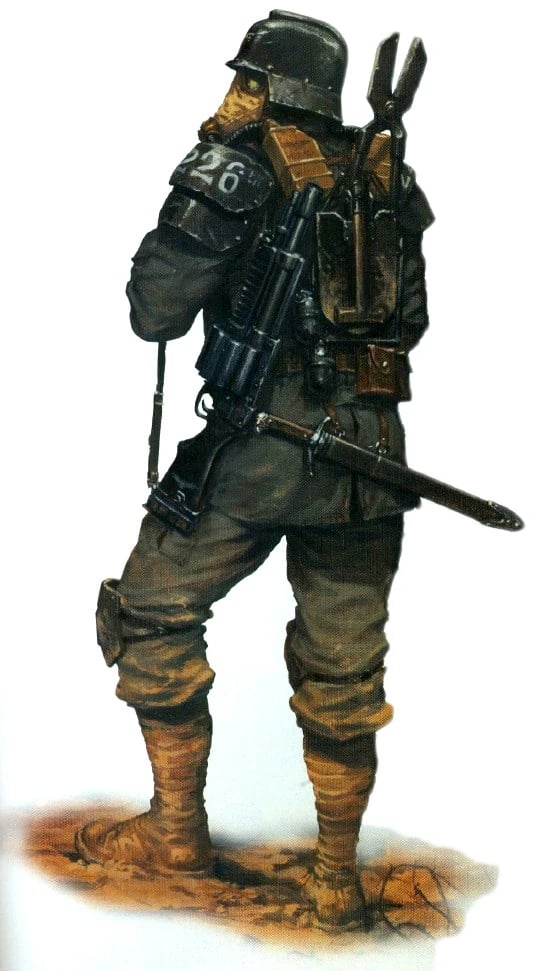

But the most dangerous weapon of engineers is poisonous gas. Each engineer carries a cylinder of such gas with him and, if necessary, releases it at enemy positions. This is a cruel, monstrous, inhumane method of warfare, which the Kriegs use only as a last resort, when all other options have been exhausted. However, it was the chemical weapons of Krieg's engineers that helped turn the tide of many campaigns that otherwise would have resulted in the defeat of the Imperial forces.
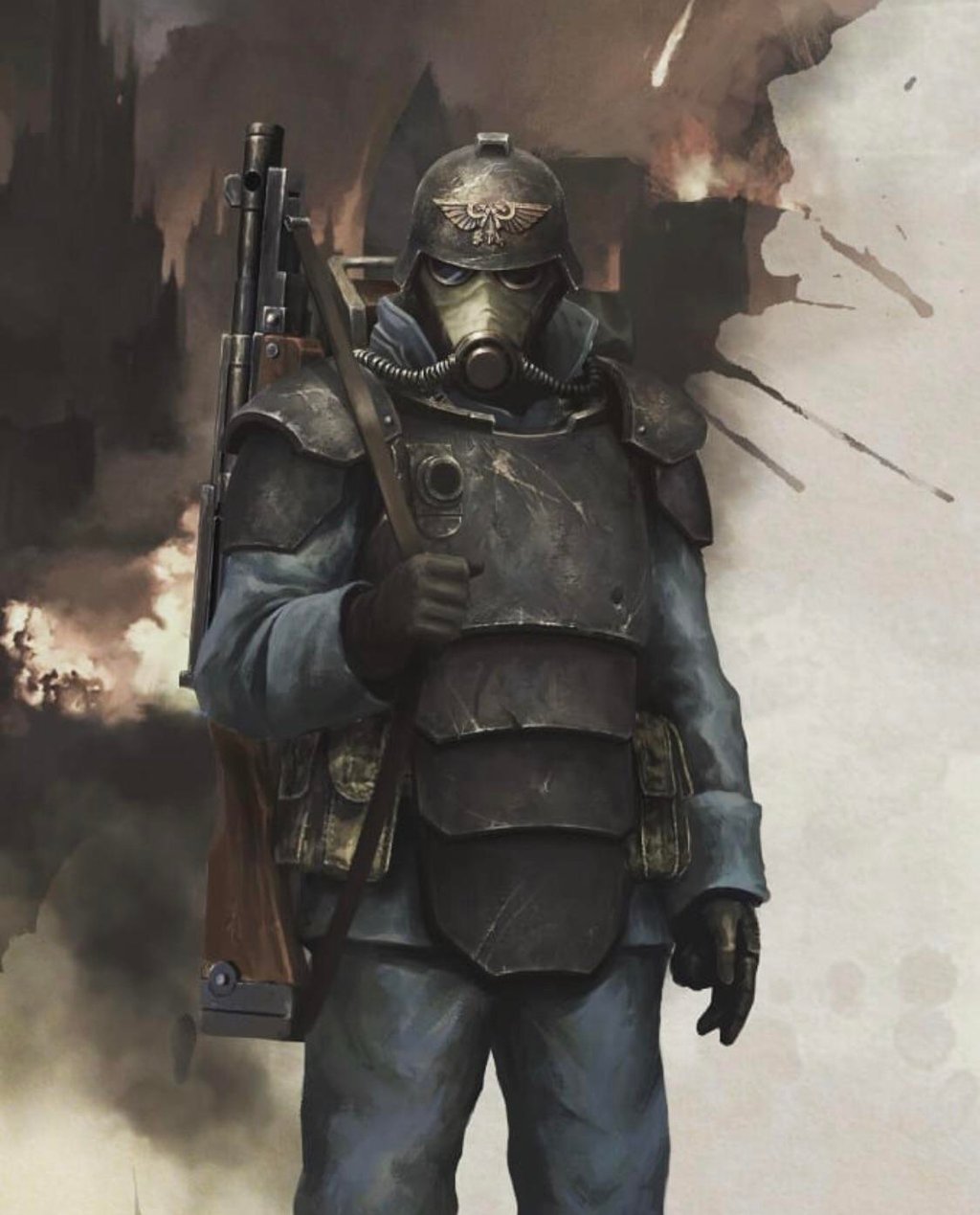

Technically performs the functions of a field medic, but not primarily. The history of this unit goes deep into Krieg's past, when during the centuries-long civil war the task of rescuing equipment often took precedence over the need to save people. In addition, a soldier who could not be returned to battle immediately became a liability and was put to death by military execution to prevent him from falling into the hands of the enemy.
Quartermaster
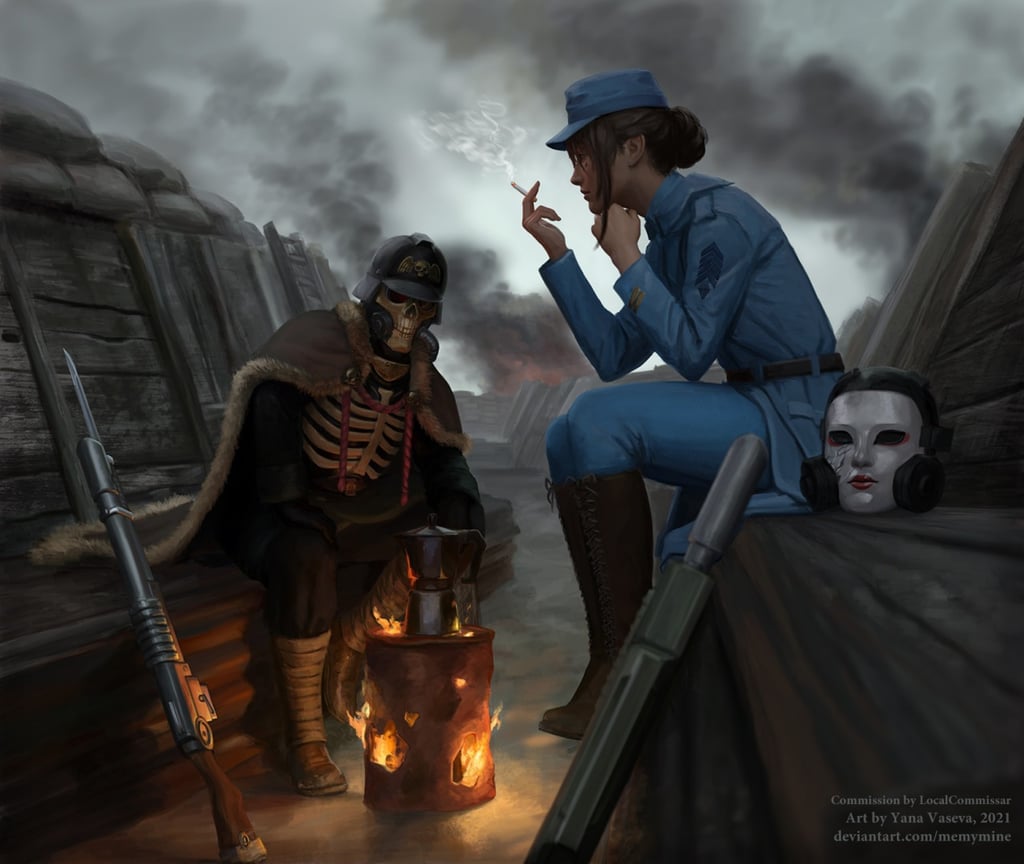

Today, the Astra Militarium provides excellent supplies to the Krieg people, and medicine on the galactic fronts is not at all the same as it was in the wastelands of Krieg, where doctors sometimes lacked basic antibiotics. However, the Death Korps have decided to preserve this cruel tradition, so the Quartermasters do not save the seriously wounded, instead granting them a quick and, it is believed, a glorious death. In battle, Quartermasters collect the equipment of the fallen, and after the battle they repair and redistribute it.
Quartermasters are recruited based on two criteria - high intelligence and exceptional loyalty. Exceptional even by the standards of the Kriegs themselves. And this is probably fair, because only an absolute fanatic can perform these functions. The Death Korps soldiers are sure that the last thing a true Krieg citizen should see is the Quartermaster's skull mask.
Death Korps Equipment
During the civil war, that is, before the return to the fold of the Imperium and the conclusion of a pact with the forge world Lucius, the vast majority of Krieg infantrymen were armed with autoguns and heavy stubbers. At the moment, the main weapons of the Death Korps are the standard Lucius lasguns (produced on that same forge world) and the heavy Type XIV lasguns, known as hellguns. Grenadiers, as already mentioned, use meltas, as well as mortars, lascannons, autocannons, flamethrowers and even heavy bolters.
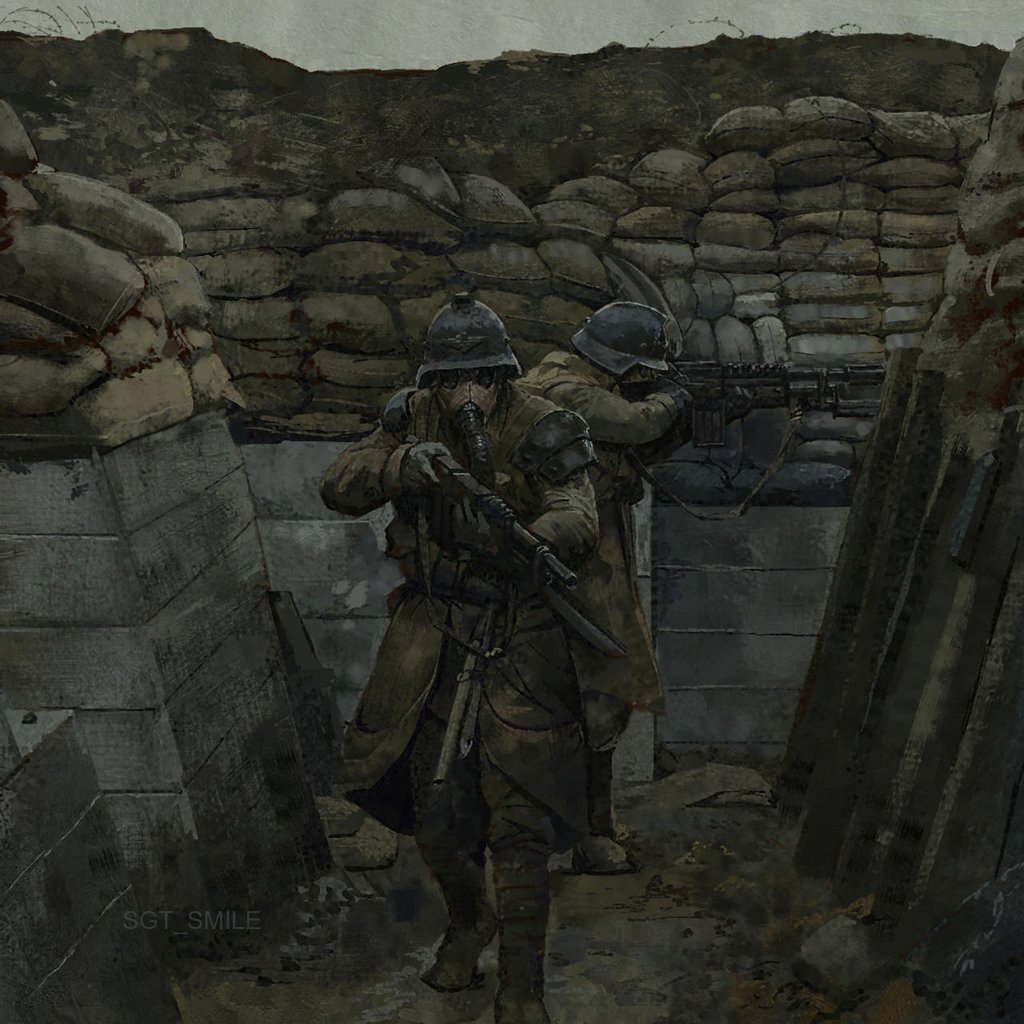

Most infantrymen wear lightweight so-called anti-aircraft armor, and only grenadiers use heavy armor. The standard kit includes a bayonet with a monomolecular sharpening and several sets of grenades (fragmentation, smoke, flash-noise).
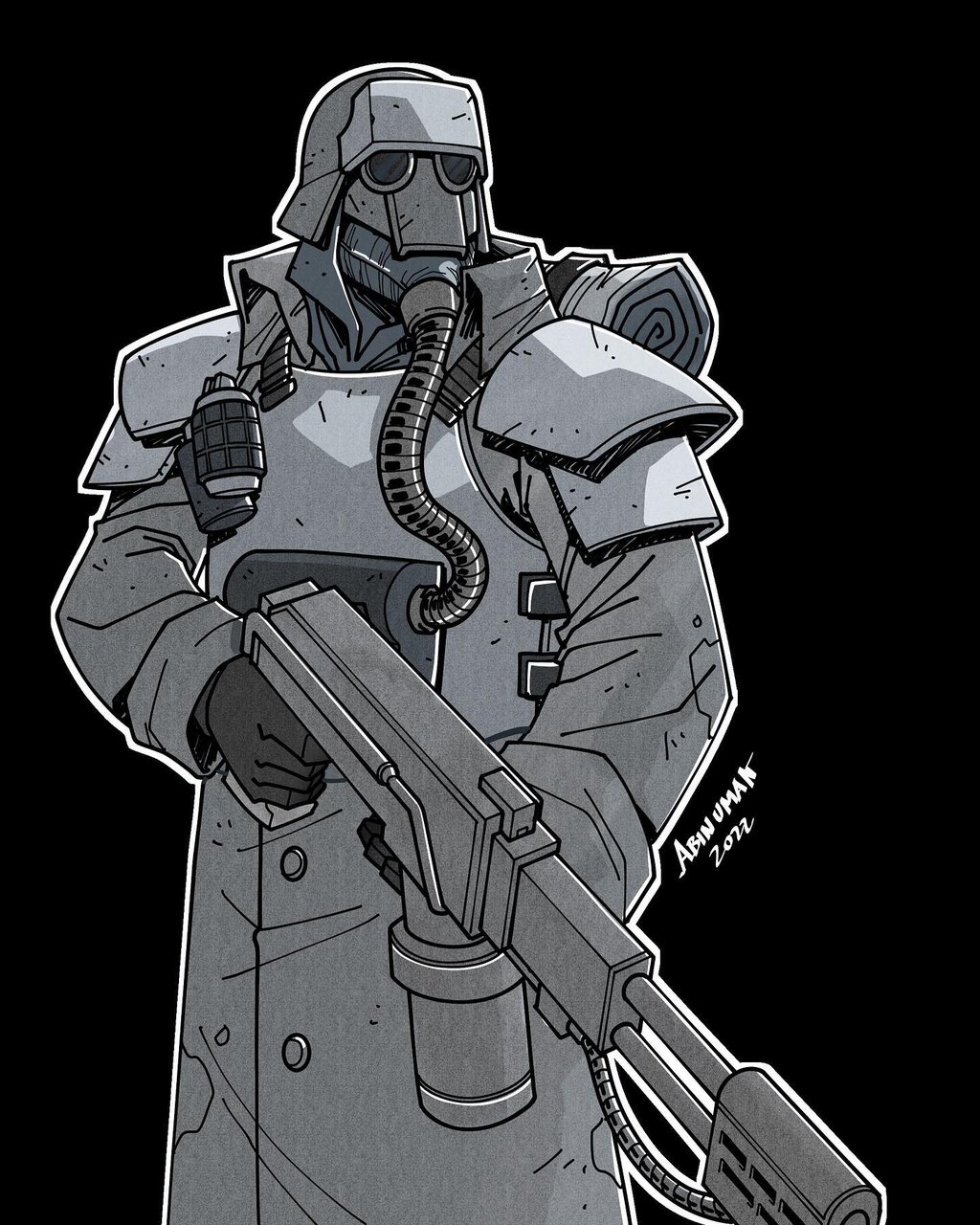

Each infantryman in his backpack contains a set of tools, a sapper shovel, a sleeping bag, a blanket and a mobile tent, a battery lamp, a set of screamers (issued to the detachment), a personal hygiene kit, KLM and a two-week ration (including a supply of water). This equipment makes each Krieg soldier completely self-sufficient and capable of surviving even alone in potentially any conditions.
Oh yes! Every Krieg soldier always has in his greatcoat pocket the beloved and well-read Inspirational Manual of the Imperial Infantryman.
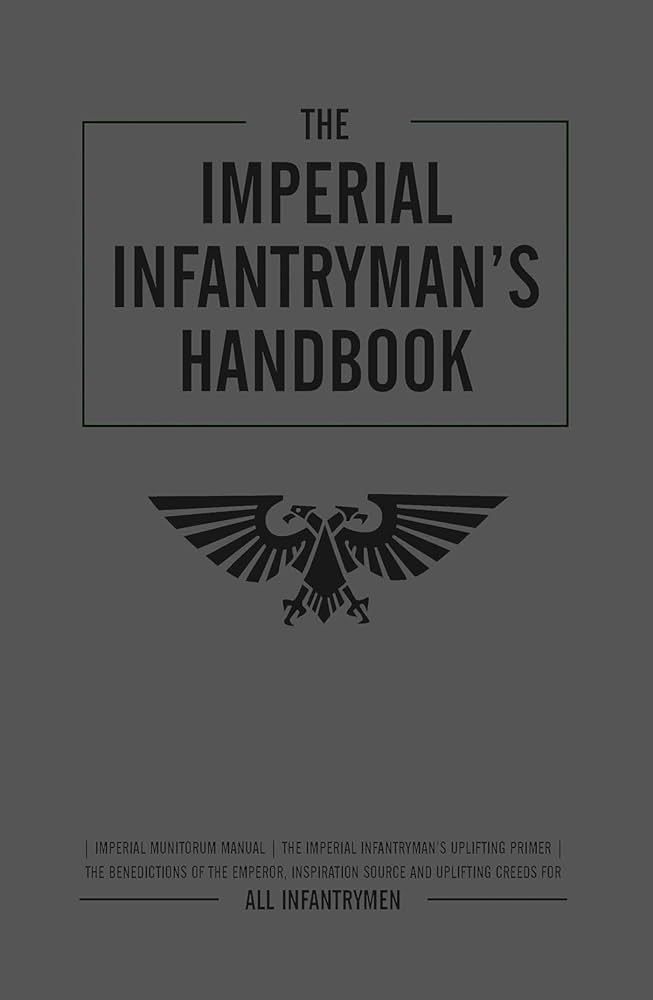

The most famous military campaign in which the Kriegs took part was, of course, the Siege of Vraks (813-830.M40). The campaign lasted 17 years, at the end of which the forge world Vraks Prime was cleared of the forces of Chaos
Notable campaigns
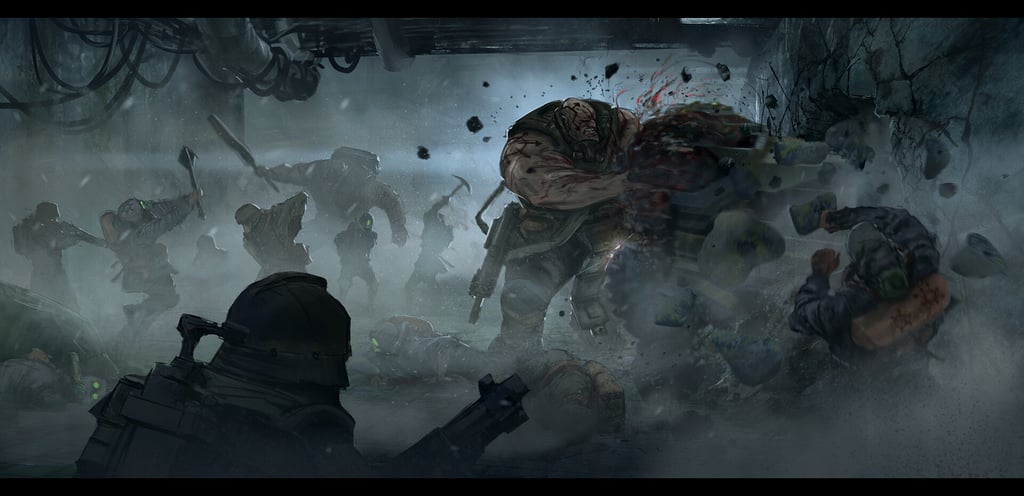

Krieg's Death Korps helped quell the rebellion on the Hive World of Derondis. This campaign lasted from 936 to 946.M41. As a result, the Kriegs reduced Derondis to ruins until the rebels capitulated.
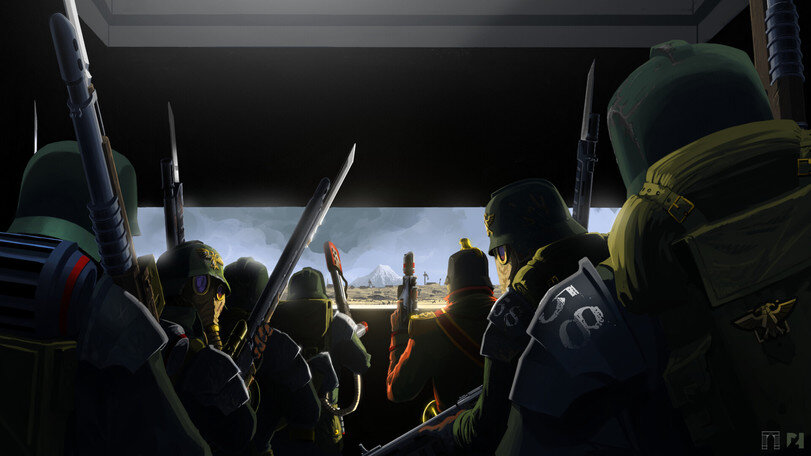

Also in M41, Krieg fought against the Necrons in the Battle of Hieronymus Theta and in the Orpheus Wars. In the Dusca Campaign, the Kriegs successfully acted against the demons of Nurgle, and during the Obron of Fecundia, the Death Riders fearlessly fought the tyranids of the Kraken hive fleet.
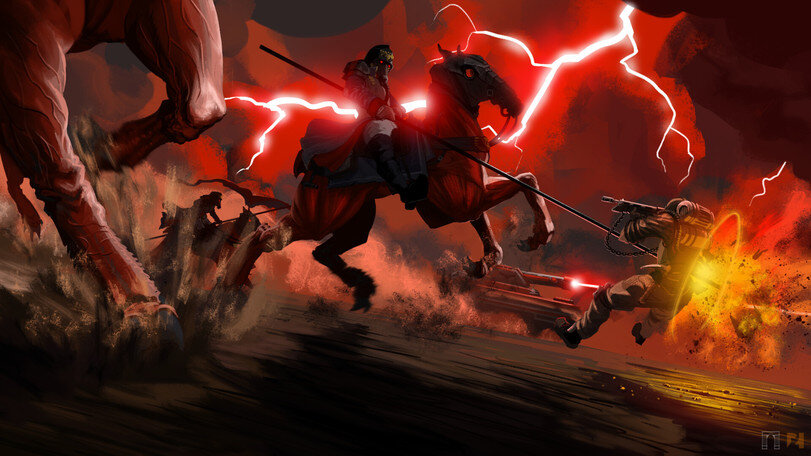

As already mentioned, the Kriegs fought in the Third War for Armageddon, as well as in the Taros Campaign, which turned out poorly for the Imperial forces. At the moment, the last campaign in which the Kriegs fought was the defense of Tarsis Ultra from the Tyranid Hive Fleet Leviathan.
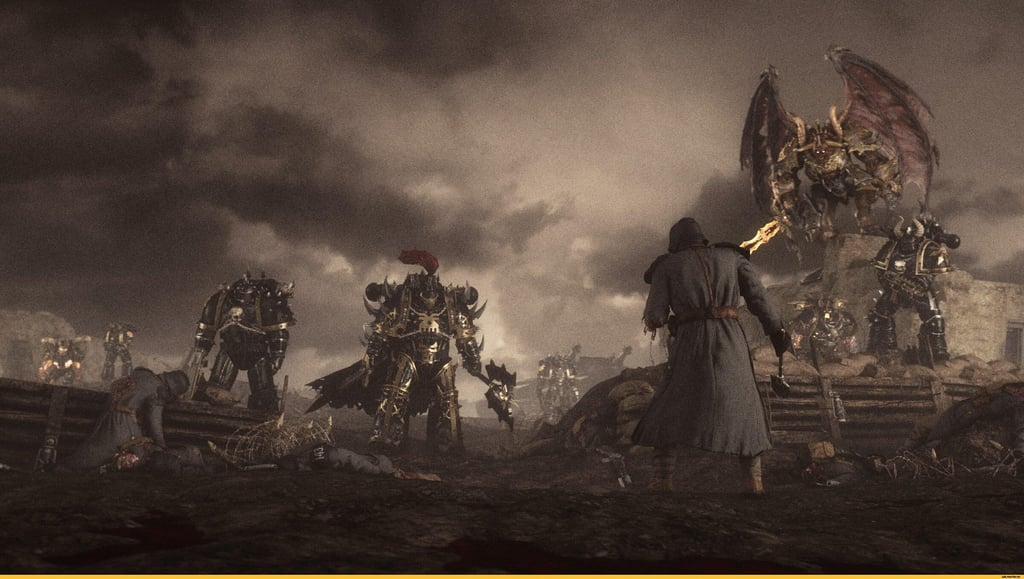

Origins of inspiration
Many military units from the Warhammer lore have prototypes in real earthly history. With the Death Korps of Krieg everything is simple - it is the Reichsheer, or the German Imperial Army (Deutsches Kaiserliches Heer). This name was borne by the ground forces of the German Empire in the period from 1871 to 1919.
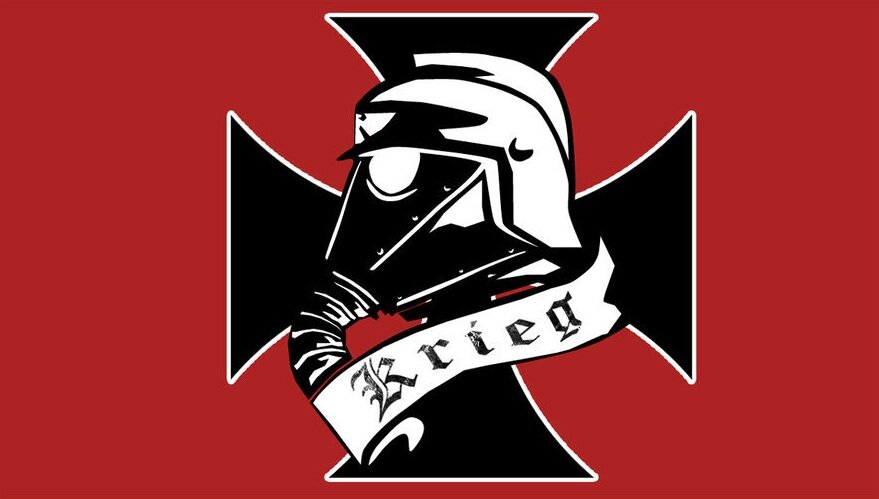

Actually, the very name of the Krieg planet is German. Krieg means “war” in German (you’ve probably heard it as part of two-syllable words like “blitzkrieg” and “kriegsmarine”). Moreover, the emblem of the German army during the First World War was the so-called Iron Cross, which “grew up” from the Teutonic cross (the symbol of the German spiritual-knightly order Ordo Teutonicus) and was later transformed into the Balkenkreuz, the identification mark of the Wehrmacht. So on the flag of Krieg there is the same Iron Cross, not even stylized (the only nuance is that the background is red, the Reichsheer had a white one).
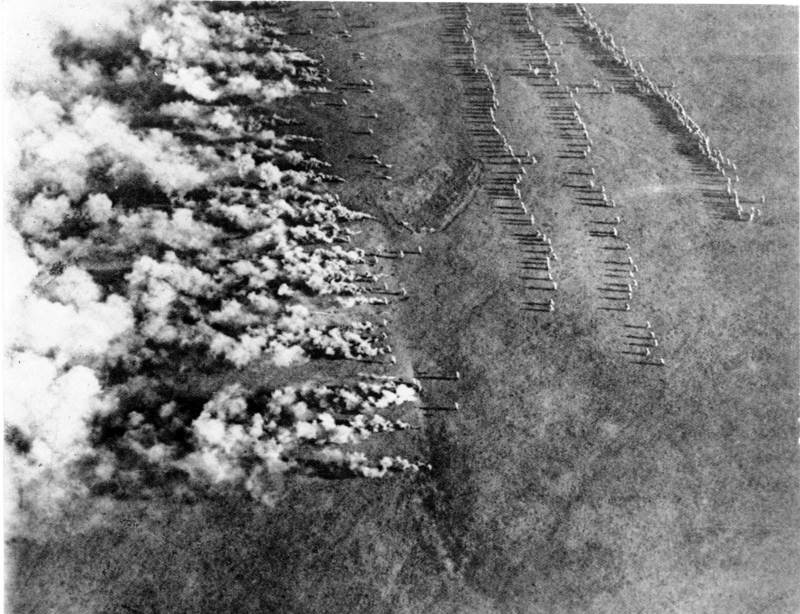

And of course – Krieg gas masks. German troops in gray greatcoats with gas masks on their faces have long become a stereotypical symbol of the First World War. And this stereotype is deserved, because the Germans were the first in the world to use chemical weapons in a large-scale military conflict (Second Battle of Ypres, April 21 - May 25, 1915, by the way, that gas was called mustard gas). Actually, they used their “gases” more than once - just look at the third assault on the Osowiec Fortress. This episode is indicative for us in one more aspect, but more on that later. Now let’s remember the Death Korps engineers with chemical weapons and “tunneler” tactics.
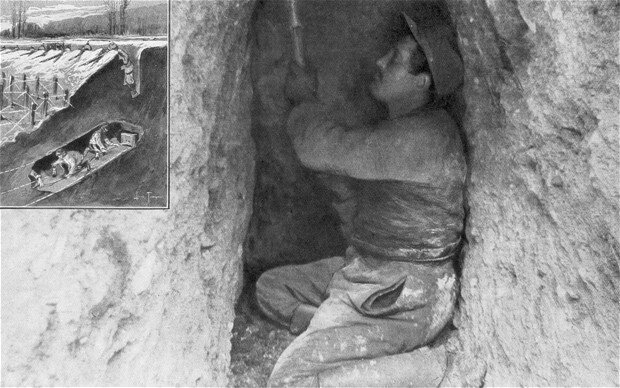

I think there is no need to talk about the so-called tunnel wars. Moreover, it was the Germans who were the first to decide to “undermine” the front line, go to the enemy’s flank and rear, and blow up strategically important positions. The British happily adopted the tactics and trench warfare moved to a new level. More precisely, it went down to a lower level.
As a result - the name, emblem, uniform, gas masks, chemical weapons, miner tactics, and also characteristic helmets. There are enough facts to leave no doubt that Krieg was “written off” from the Reichsheer. But - only externally.
We return to the Osowiec Fortress. After the gas attack during the third assault on August 6, the Germans moved to the positions of the Russian Empire and... we all know very well what happened next - this event was called in history the Attack of the Dead. So - the Germans fled (which, damn it, is completely natural in those circumstances!). And we know that the Kriegs NEVER retreat. Therefore, it is obvious that ideologically Krieg is in no way the heir of the Germans during the First World War. But does the image have a real background?
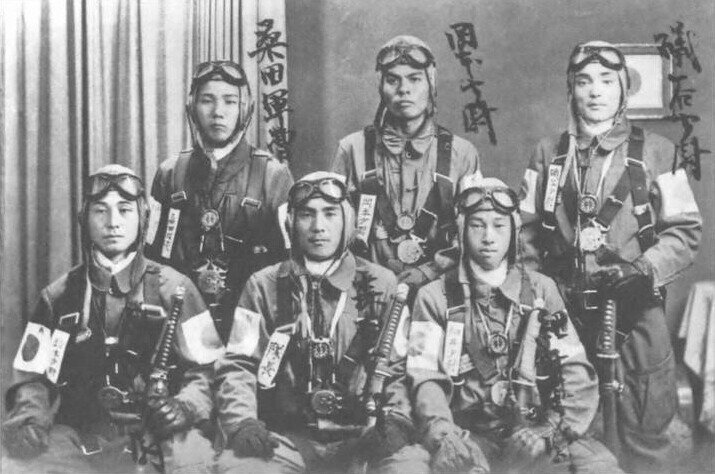

To me, the closest historical analogues seem to be the Japanese kamikazes of World War II - tokkotai and simpu (they were called that way; the word “kamikaze” was introduced into public circulation by American propaganda). For them, death in battle with the name of the Emperor on their lips was the highest goal, without exaggeration. How much of this was ideology, and how many went to their deaths for completely pragmatic reasons is a secondary question. The fact is important to us. Although, in fact, you can dig deeper – right down to bushido. After all, the meaning of a samurai’s life is service. For him, circumstances under which he could dishonor his master are unthinkable. And the samurai is ready to accept death for him at any second.
So the Death Korps of Krieg turn out to be a combination, and not everything with these death machines is as simple as it seems at first glance. There are many interesting military formations in the lore of Warhammer, but the Kriegs are definitely one of the most colorful and... inspiring.
